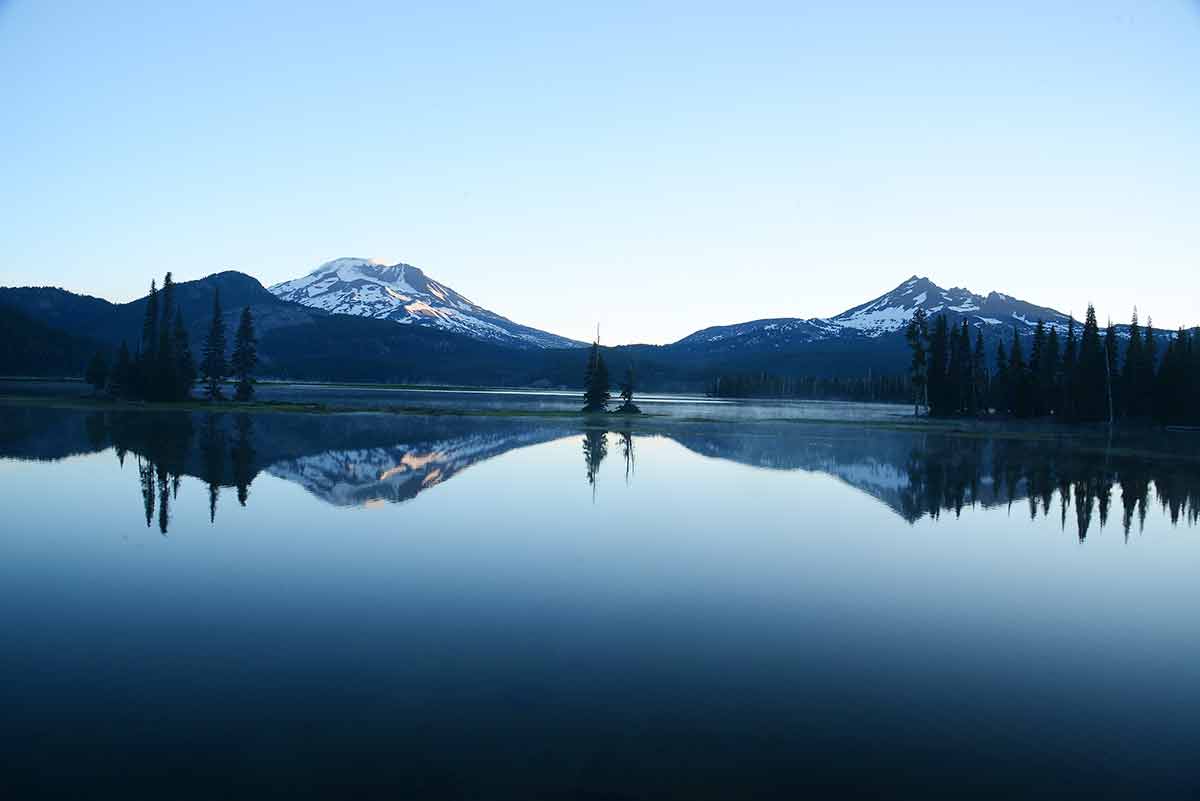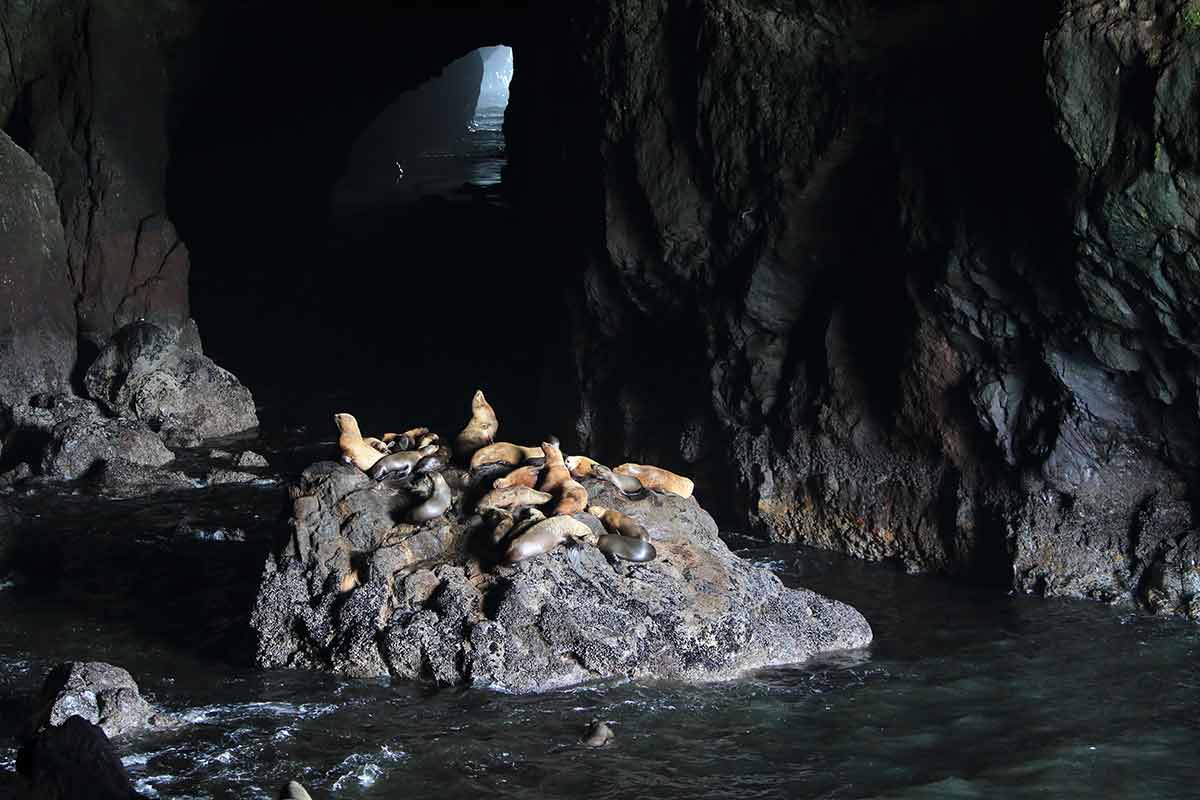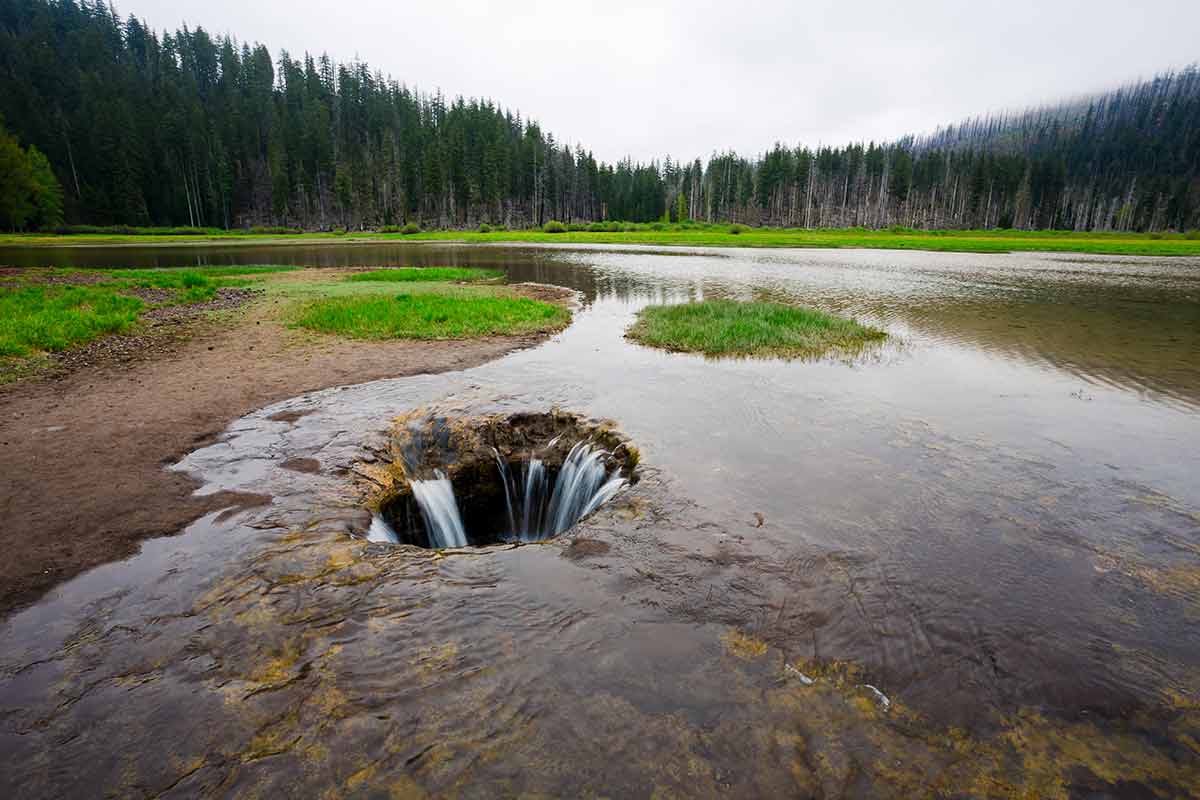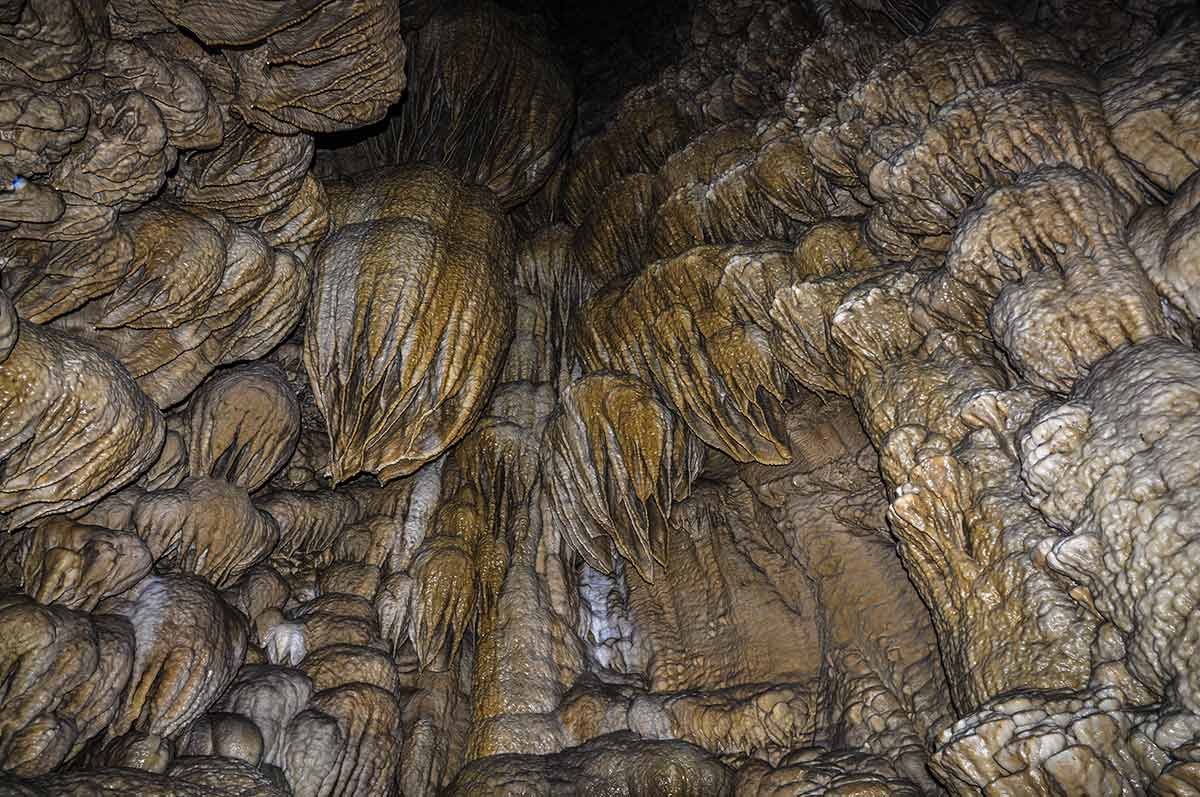A US state in the Pacific Northwest, Oregon is known for its natural attractions. From lush pine forests to the misty Oregon Coast to fascinating volcanic formations, Oregon is brimming with natural beauty and is riddled with caves. The caves in Oregon are incredibly diverse. From lava caves to glacier caves to sea lion caves, Oregon has it all. These caves feature a variety of geology, flora and fauna for adventurous visitors to explore.
Make sure to bring close-toed shoes, backup light sources, and warm clothing, no matter which cave you visit. Pets are generally not allowed in the caves to prevent the spread of animal-borne diseases to the resident bats. Here’s a guide that will give you a taste of the history and geology of Oregon’s caves, how to access them and what to do during your visit.
Contents
Caves In Oregon
Top Tours
- Full-Day Guided Oregon Coast Tour – from Portland
- Northern Oregon Coast Day Trip – to Cannon Beach Area
- Private Northern Oregon Coast Day Trip – choose your own itinerary
12 Incredible Oregon Caves To Explore
1- Lava River Cave

Located just a 15-minute drive south of downtown Bend, the Lava River Cave Interpretive Site offers self-guided tours of a winding lava tube.
Over 1 mile (1.6 km) long, the lava tube was one of the first of its kind to be discovered in Oregon.
The location of Lava River Cave places it at the junction of the Cascade Range, the Northern Great Basin, and the Southern Columbia Plateau.
Although several native tribes lived in these areas, the earliest evidence of Euro-American cave exploration dates back to 1889.
The entrance to this cave has two different ecosystems: one characterised by a dry, warm climate and a microsystem that arises from the cool air at the mouth of the cave.
The former cultivates an ideal environment for bitterbrush and ponderosa pine, while the latter provides conditions for raspberries, strawberries, and currants.
To enter the cave, you’ll have to descend 55 stairs, followed by a journey that combines more stairways, boardwalks and bumpy stone surfaces.
It takes about 1.5 hours to explore the cave roundtrip.
Lava River Cave is off Highway 97, just off Exit 151 (Cottonwood Rd). Turn left after the exit, then follow the signs to the cave.
2- Boyd Cave
Boyd Cave is tucked away in the Deschutes National Forest on the northern side of Newberry Volcano.
Like Lava River Cave, Boyd Cave is a lava tube formed thousands of years ago.
The cave is well-preserved; there is little interior collapse, and fascinating lava flow patterns can be observed on its walls and ceiling.
To enter Boyd Cave, you’ll have to descend a short stairway through a skylight with a diameter of 10 feet (3 m).
The only company permitted to give tours of Boyd Cave is Wanderlust Tours. But, if you like adventure, you can also tour the cave on your own.
To get to Boyd Cave, take Exit 143 from Highway 97 and turn right onto China Hat Road, then after driving 7 miles (11 km), turn left to park at the Boyd Cave Day Use Area.
3- Sea Lion Caves

The Sea Lion Caves, designated by the Guinness Book of World Records as the largest sea cave in the US, sits west of Eugene, right along the Oregon coast.
This large cave is connected to the ocean, but visitors can come to check it out for a fee to support the preserve’s mission.
The privately owned sanctuary and wildlife preserve help protect marine wildlife and the environment.
As it’s not a zoo, the sea lions aren’t always inside the cave.
Depending on the time of year, they might hang out on the rocky ledges in front of the cave.
Sea lions tend to be inside the cave during the winter and outside the cave during the spring when it’s breeding and birthing season.
The sea lions living in the cave are Steller sea lions, which can weigh up to 2,500 pounds (1,120 kg) and swim up to 17mph (27 km/h).
Today, a herd of roughly 200 Steller sea lions live in the Sea Lion Caves, so if you’re in the area where the sea lions are visible, check out this cave.
The Sea Lion Caves is at 91560 US-101, Florence, OR 97439, United States.
4- Arnold Ice Cave
Arnold Ice Cave is an excellent destination for adventurous explorers at the southeast of Bend (close to Boyd Cave) and is hidden underneath the juniper and ponderosa pine trees.
Arnold Ice Cave formed approximately 80,000 years ago after a river of flowing lava was exposed to air.
This cave system features Native American artefacts that have been carbon-dated as early as 1370 AD.
Arnold Ice Cave is full of ice, as its name implies.
Ice stalagmites cover parts of the ground and large ice structures that sometimes block off parts of the cave.
Bring plenty of warm clothes and proper footwear.
To get to Arnold Ice Cave, continue on China Hat Road, just a bit past Boyd Cave, then turn right onto Swamp Wells Road and look out for signs to the cave.
5- Sandy Glacier Caves
Check out the Sandy Glacier Caves if you’re craving an adventure in yet another icy cave as this cave system is part of the largest glacial caves in the lower 48 states of the US.
The system is nestled within the ice of Mount Hood’s Sandy Glacier.
The majestic caves are reminiscent of the otherworldly ice caves around the globe.
Sun can gleam through the pale blue ice, and a blanket of snow covers the ground inside and out.
At the end of the summer, the individual caves are named the Frozen Minotaur Cave, the Pure Imagination Cave and the Snow Dragon Cave.
However, besides this period, the caves become connected by perennial ice and are collectively called the Snow Dragon Glacier Cave System.
Make sure to check out the Sandy Glacier Caves as soon as you can because as the glacier melts, scientists have predicted that the caves will no longer exist by the end of the decade.
The hike to the caves is rather lengthy.
You can begin the 10.8-mile (17.4-km) hike at Top Spur Trailhead and when you reach McNeil Point, hike about a mile (1.6 km) off-trail to the caves.
If you’re experienced, you can camp inside the wintry caves but pack the right equipment.
Top Spur Trailhead is roughly 57 miles (91.7 km) east of Portland.
6- Paisley Caves
The Paisley Caves complex consists of four caves to the north of Paisley.
While these caves are not as deep as the lava tube caves, they still make for an incredible visit due to their archaeological significance and findings.
The oldest human DNA yet discovered in both the Americas was found in 2007.
This DNA was radiocarbon-dated to approximately 12,000 BC and was uncovered in coprolites roughly seven feet (2 m) below the ground.
The Paisley Caves are in the dry Oregon desert.
Carving out a small cliffside, they overlook a desolate landscape of dry grass and sagebrush.
Due to the excavations and the artefacts, visitors can’t explore the caves themselves, but you can still hike up the hill to walk along the caves and look down into the excavations.
The Paisley Caves are on the rock ridge known as Five Mile Point, which is close to the southeast edge of the Summer Lake Basin.
7- Fort Rock Cave
Before the Paisley Caves were discovered, Fort Rock Cave was the site of the earliest physical evidence of human life in Oregon.
Although the cave is rather shallow, and you can’t explore inside, it is an important reminder of Oregon’s history.
Fort Rock Cave Basin is a site important to the history of native Oregon tribes.
Several pairs of sagebrush sandals dated to be between 9,000 and 10,000 years old were discovered here. And tribes continue to tell rich oral stories about the cave’s surrounding area.
This national historic landmark that’s only open for a guided state park tour, so make sure to book in advance.
On tour, you’ll learn about the cave’s history and geology.
Fort Rock State Park is at Fort Rock Rd, Fort Rock, OR 97735, United States.
8- Derrick Cave

Derrick Cave is yet another lava tube cave that draws visitors to Oregon.
The cave is in the high desert of central Oregon, in northwest Lake County and although experts are unsure of the cave’s age, it is estimated to be between 6,845 and 13,000 years old.
The lava tube is 0.25 miles (0.4 km) deep, 30 feet (9 m) high, and 50 feet (15 m) across.
Besides the skylights at the beginning of the massive cave, it’s pitch black and the perfect home for bats.
Visitors may access the cave, but there are no professional tours and no facilities at the cave. So, if you want to explore the depth of Derrick Cave, make sure you bring the right equipment.
The cave also has a fascinating history as during the 1960s, it was a nuclear fallout shelter stocked with a supply of water and food.
To get to Derrick cave, you’ll have to drive on an unpaved, unmaintained dirt road that requires a 4WD, especially in winter and during the rainy months.
Figuring out how to Derrick Cave can be complicated, so follow the official directions from the Bureau of Land Management.
From Bend, head east on US20 before turning right onto Moffitt Road, then turn left on NF-23/Sand Springs Road. Take another left on NF-2325 and drive straight until you reach the parking lot for Derrick Cave.
9- Redmond Caves
The Redmond Caves Recreation Site is in the central Oregon city of Redmond.
The site has five different caves formed by flows of Newberry Caldera molten lava.
The individual caves have fascinating names: Redmond Cave, No Account Redmond Cave, Cave Next Door, Lions Cave and Insignificant Redmond Cave.
Native Americans utilised the caves for the past 6,000 years, making them an excellent site for learning about native history and past human cave use.
Like Derrick Cave, the Redmond Caves were later used as fallout shelters by the US government.
The caves are open year-round and are preserved in their natural state.
You can check out the caves’ unique geology, but watch out for rattlesnakes in the Oregon high desert and surrounding area.
The Redmond Caves are just 0.8 miles (1.3 km) away from the Redmond Airport, making them a great destination if you have extra time before a flight.
The caves are on SW Airport Way, between the Deschutes County Fairgrounds and the airport.
10- Horse Lava Tube System
The Horse Lava Tube System is a set of caves that includes the Redmond Caves, however, this system covers a vast network of 122 caves, making its Redmond subgroup small in comparison.
There are more than 22,000 feet (6,705 m) of explorable passage in the entire system.
The Horse Lava Tube System is part of the basalt of Lava Top Butte, and it has a geologic age of roughly 80,000 years old.
The basalt flow that created this cave system extends beyond Crooked River Ranch and ends just before the Crooked River Gorge.
There are three main types of caves in the Horse Lava Tube System – spatter cone caves, rootless vent caves and lava tube caves – and other minor cave types, such as talus caves and surface tubes.
Highlights include the Horse Caves, Youngs Cave, Stevens Cave and Lewis Farm Cave no. 1.
Not all caves are on public property, so once you find specific caves that interest you, do your research on visiting rules.
11- Skylight Cave
Skylight Cave is one of Oregon’s most aesthetically pleasing caves to explore and its most unique feature, which gives the cave its name, is the highlight of the cave.
You’ll need to descend the sturdy metal ladder to enter Skylight Cave.
Once entering, turn right and explore the cave for 900 ft (274 m), or you head left and walk about 300 ft (91 m).
If you take the latter option, you’ll see three holes in the top of the cave.
These skylights give the cave its name, allowing the sunlight to pierce the darkness.
These brilliant beams are best seen in the morning on a cloudless day during late spring or early summer.
Skylight Cave is closed from late September to early May for the hibernating bats.
Skylight Cave is approximately an hour northwest of Bend. To get there, take the road north out of Bend before passing through Sister. Then, drive west on McKenzie Highway before turning onto a marked dirt road. After driving a few miles, you’ll reach Skylight Cave.
12- The Oregon Caves

The Oregon Caves National Monument and Preserve lies deep within the Siskiyou Mountains in southwestern Oregon.
The so-called “Marble Halls of Oregon” was formed by acidic water eating into rock over thousands of years and lie within a 4,554-acre (1,843 ha) park of winding caves and land.
The Oregon Caves offer several types of guided tours for visitors, each with its own unique features.
These include the Candlelight Cave Tour, the Discovery Cave Tour, and the Kids and Family Day Tour.
However, you aren’t always required to explore the caves through a tour; depending on the time of year, you can also go off-trail caving.
This requires more experience and equipment, as off-trail caving might require squeezing into tight places.
When you’re not exploring the national monument’s caves, you can go on a hike or check out the wildlife.
The caves and surrounding areas, which foster diverse ecosystems, are home to several creatures.
Keep an eye out for Pacific Tree Frogs, the Pacific Giant Salamander, bushy-tailed woodrats, and sooty grouse inside and outside the Oregon Caves.
Don’t forget to check out the Oregon Caves Visitor Center, where you can learn about the ecosystems and geology of the caves and the Siskiyou Mountains.
The Oregon Caves National Monument and Preserve is at 19000 Caves Hwy, Cave Junction, OR 97523, United States.
For more about the Pacific Northwest, read:
- 20 Idaho Landmarks
- 6 National Parks In Idaho
- 20 Things To Do In Rathdrum Idaho
- 20 Things To Do In Blackfoot Idaho
- 20 Things To Do In Kuna Idaho
- 20 Things To Do In Rupert Idaho
- 20 Things To Do In Idaho Falls
- 20 Things To Do In Twin Falls, Idaho
- What Is Idaho Famous For?
- 21 Beaches In Seattle
- 20 Landmarks In Washington State
- 20 Seattle Landmarks
- Seattle At Night
- 21 Things To Do In Vancouver WA
- 15 Washington State National Parks
- 20 Washington State Parks
- 20 Cities In Washington State
- 20 Things To Do In Bellevue
- 20 Things To Do In Bellingham
- 20 Things To Do In Yakima WA
- 20 Things To Do In Port Angeles
- 20 Things To Do In Wenatchee
- 20 Things To Do In Olympia
- 20 Things To Do In Spokane
- 20 Landmarks in Oregon
- 20 Beaches in Oregon
- 20 Things To Do In Bend (Oregon)
- 12 Caves In Oregon
- 7 National Parks In Oregon
- 20 Things To Do In Eugene Oregon
- 20 Things To Do In Salem, Oregon
- 20 Things To Do In Medford, Oregon
- 20 Things To Do In Lincoln City
- 20 Things To Do In Seaside
- 20 Waterfalls in Oregon
- 20 Things To Do In Cannon Beach
- 20 Things To Do In Astoria
- 20 Things To Do In Corvallis
- 20 Things To Do In Florence
- 20 Oregon Cities
- 20 State Parks in Oregon
- 15 Things Oregon is Famous For
- 20 Things To Do In Hood River
- What Is Oregon Famous For?
Plan Your Trip

Rent A Car – Find the best car rental rates at Discover Cars. They compare car hire companies to provide you with the best deal right now.

Find A Hotel – If you’re curious about this article and are looking for somewhere to stay, take a look at these amazing hotels.





